Red Fox Breeding - Mating & Monogamy
In his contribution to the 1975 compendium The Wild Canids, renowned behaviourist Mike Fox classified the canids into three groups, based on their breeding system. Fox considered Vulpes to be "Type 1" canids based on them being temporarily monogamous -- i.e., the pair separate after the young have reached independence. Historically, however, it was long considered that foxes were entirely monogamous and, in their 1935 paper in the Proceedings of the Zoological Society of London, Idwal Rowlands and Alan Parkes noted:
"The silver fox [a black form of the red fox] is peculiar in that the great majority are strictly monogamous. This is so well defined that pairs have to be put together some time before the breeding season, and if a male dies or refuses to mate when the time comes it is difficult or impossible to find another male which will mate with his female. If one dog is paired up with two vixens he will mate with one, probably the first in oestrus, and ignore or fight the other."
Similarly, in his 1952 book, British Mammals, L. Harrison Matthews wrote:
"The male is monogamous and usually mates only once with his vixen; should his mate be killed he usually refuses to take another, forming an example of faithfulness unknown in other wild animals."
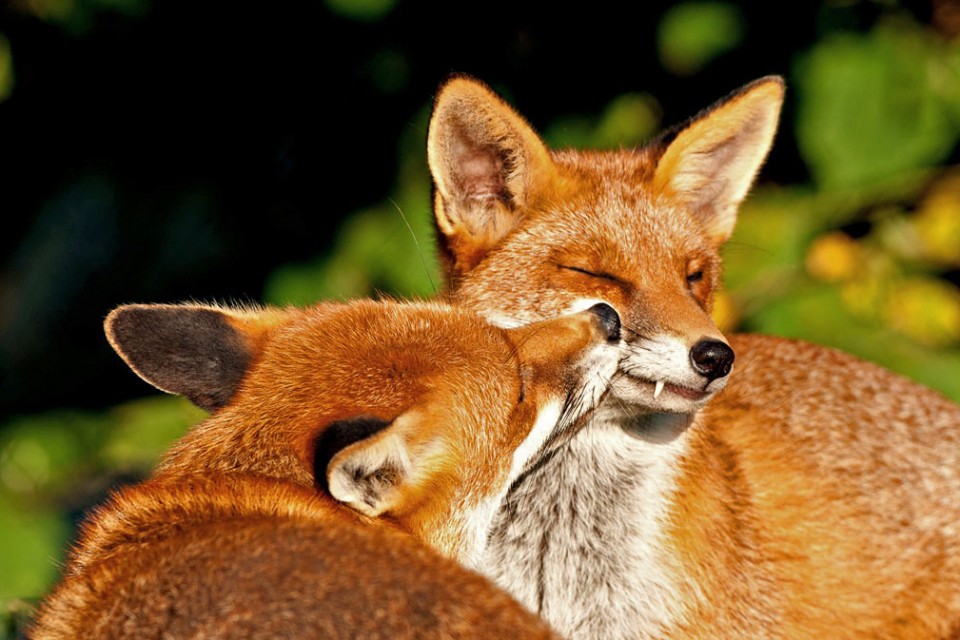
The belief that foxes were monogamous was still conventional wisdom during the mid-1990s, albeit that some naturalists have had their suspicions this may not be the case for a while. In a rather obscure paper to the Scottish Zoo and Wildlife magazine in 1949, Northumberland naturalist Henry Tegner wrote:
"Knowledgeable authorities on the fox such as J. Otho Paget and J. Fairfax-Blakeborough stress the monogamous nature of the dog fox but, just as we get the philanderer amongst humans, I am convinced we get the same in the vulpine race."
Monogamy is generally rare among the mammals and in the vast majority of cases it is actually social monogamy that is seen -- i.e., a new partner will be accepted following the death of the previous one. The situation in foxes is rather complex and, as we shall see, the presence of monogamy or promiscuity is largely based on resource availability and population density.
Initially at least, foxes do appear monogamous in that they tend to live in pairs (or small family groups) and the dominant male will mate with the dominant female. This pair-bond seems to last for life, although high mortality in some populations can mean that some 80% of the breeding population may be comprised of new pairings, owing to the death of one partner. There are reports of apparently strong emotional attachments between the pair, and Macdonald recounted a curious "mourning" behaviour in a dog fox after his mate and cubs were killed when the earth was dug out and gassed; he wandered almost the entire territory boundary barking periodically with the staccato wow-wow-wow call so familiar among foxes. I shall return to the topic of monogamy shortly, but shall first cover the process leading up to copulation.
It pays to advertise
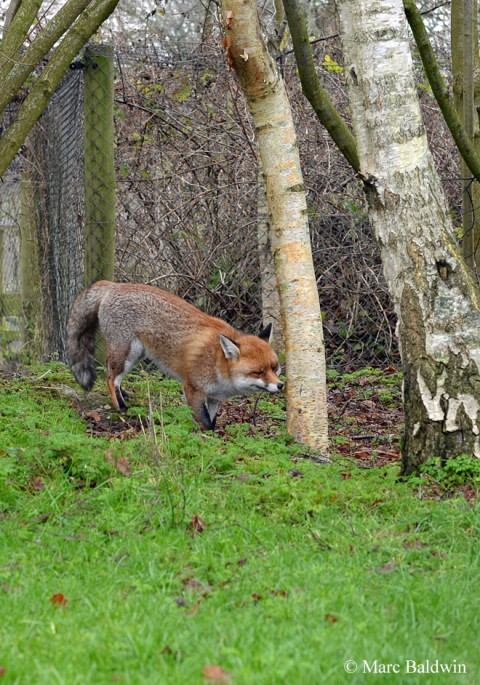
As mentioned, the vixen comes into oestrous for around three weeks during the winter and, for between one and six days of this period (oestrus), she is receptive to being mated by the dog. Consequently, the dog frequently "mate guards" during these few weeks -- the dog and vixen sleep, travel, and even hunt together (usually with the dog trailing the vixen) and as the vixen approaches oestrus she may permit mating attempts by the dog. In some cases, more than one male may court the attentions of a single female and there is a report from Pogonno-Losinoe Island reserve in Moscow of four males pursuing a single vixen.
David Macdonald observed that, as the vixen approaches oestrus, the male follows as close as the vixen will allow, holding his brush "ram-rod straight", urinating on every object he passes and showing no discernible interest in food. The dog will also closely investigate any scent marks that the female leaves and an unpaired female will scent-mark frequently while in oestrous. In her 2001 book, The Blood is Wild, Bridget MacCaskill described the behaviour of her hand-reared vixen on a walk during her first breeding season:
"She pulled me along as if we could not get anywhere fast enough, leaving her mark everywhere, on pathways, patches of moss, flat-topped boulders, and generally making sure the fox world knew she wanted a mate."
Similarly, in his book, Running with the Fox, Oxford University biologist David Macdonald noted how his hand-reared vixen would "token mark" (i.e., deposit a few drops of urine on) everything in reach at a rate of eight times per minute over a period of four days up until she was mated.
The art of woo
Early attempts by the dog to mount the vixen tend to be rebuked with much gekkering and snickering from the vixen, but when she is receptive she will allow the dog to mount her and the pair will mate -- they may mate several times during her oestrus. Just prior to, and during, mating there is often much vocalisation (in the form of short wails and shrieks) from both parties and submissive posturing (see: Behaviour and Sociality) by the vixen may proceed copulation. Indeed, one of the best descriptions of fox mating I have come across is given by MacCaskill, who described the behaviour before, during and after her vixen (called Rusty) mated with a stranger. From her vantage point in a tree on a bitterly cold winter's night, MacCaskill observed:
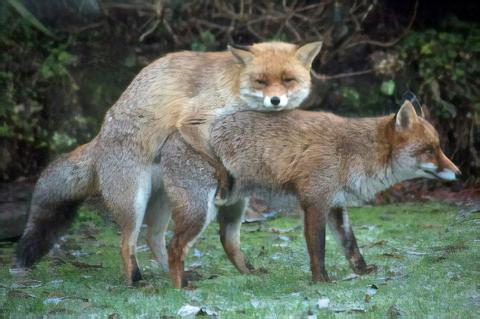
"There were squeals of excitement as they met and rapid chitterings as they rose together on hindlegs to box and bite. The dog played eager, sniffing her hindquarters. Submissive, and uttering chirruping sounds of invitation, Rusty rolled over to display her pale grey underparts. She teased him, flirted with him, led him on, all the time her eyes assessing what he would do next. Twice she stood for him, apparently willing, but each time his paw came on to her flank, she snarled and wriggled away. Preliminaries over, the vixen sauntered away, pretending indifference. The dog, eager and panting, followed at once. The vixen squatted to leave her mark. The dog barged her aside to sniff, scrape, and sniff again. More chirruping sounds from the vixen. Just as I was beginning to wonder if they ever would mate, she suddenly stood and allowed the dog to mount. The act was no different to any other we had seen -- a submissive vixen, a dog who knew instinctively what he must do, and a painful locking together, judging by the screams of rage from the vixen."
Copulation lasts only a few seconds and, following ejaculation, the pair are locked together -- a copulatory lock -- for up to 90 minutes (above), owing to contraction of the vixen's vagina and the swelling of the bulbus glandis tissue at the tip of the dog fox's baculum described earlier. Unsuccessful mounts (i.e., those that don't end in ejaculation), and there may be several in a single mating session, do not appear to result in locking. Indeed, successful (i.e., locking) matings often appear to be preceded by several 'thrust' mounts, and this thrusting behaviour may be a necessary prelude to ejaculation.
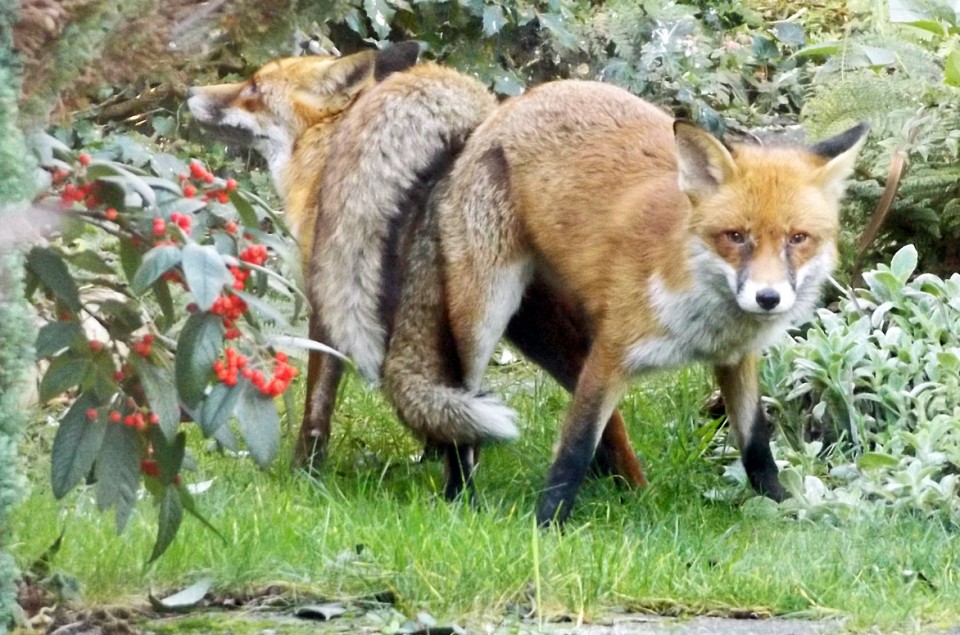
The copulatory lock evolved as a method of providing the best possible chance of fertilization, by preventing other males from mating with the vixen during this time (thereby giving the dog's sperm a time advantage over that of any competitors). Once locked the dog will lift his back leg over the vixen's back and the two will stand back-to-back: an evolutionary mechanism to allow them to defend themselves from any potential predators. This lock is apparently very strong and I have come across one (admittedly unverified) account of a lady who came out into her back garden and yelled at two locked foxes, at which point one took off over a wall, dragging the other behind it. I'm also aware of several instances where well meaning members of the public have attempted to "unlock" a mating pair, and it's not uncommon for wildlife rescues to receive calls about this during January and February. Any attempt to unlock or chase away a locked pair should be discouraged, however, as wrenching trauma while locked can result in paraphimosis, where the penis is unable to retract into the sheath, causing pain and distress to the fox and typically requiring veterinary intervention.
Curiously, in his 1999 book, Battle of the Sexes, John Sparks mentions copulatory plugs in foxes. Copulatory plugs are small jelly-like blockages that males implant in the vagina of a female with which they have just mated in a bid to prevent her mating with anyone else. It is well known among some animal groups (particularly rodents), but Sparks writes:
"In the case of foxes and of eastern grey squirrels in the USA, the females foil the males' attempts to enforce further chastity by removing the rubbery copulation plugs themselves within seconds of mating... "
While this is certainly true of squirrels, I have been unable to find any further reference to this phenomenon among foxes and wonder if Sparks is actually referring to fox squirrels -- it seems to me that the copulatory lock is essentially the male making himself a copulatory plug. Moreover, given that a male may mate with the same female several times during her oestrus, it seems unlikely he would employ a plug that would make the process more difficult for himself later on. MacCaskill went on to describe how, after about 30 minutes, the pair unlocked and stood together stretching and yawning before curling up together and going to sleep. An interesting observation from some fur farms is that their animals must be kept in complete seclusion during the breeding season otherwise they will not mate.
All for one? Or one for all?
I have mentioned that foxes often appear to pair for life, but this doesn't assume monogamy. Indeed, once the female is no longer in oestrus, the dog fox no longer needs to guard her and may leave, usually only temporarily, to seek out additional mating opportunities. Tracking studies in Bristol, for example, have revealed that, after the dominant vixen has ended her oestrus, the male often rapidly expands his range -- in many instances more than doubling the distance over which he travels -- to increase the likelihood of encountering other receptive vixens. During these reproductive movements it seems that the foxes actively intrude into the core areas of neighbouring territory (quite the opposite pattern to that seen when foxes disperse).

Dog foxes in Bristol were found to have sired cubs some considerable distance from their territory and, in one case, a male crossed through the territories of 18 neighbouring groups in search of new mates, although the "average" dog crossed 2.7 territory diameters. Presumably, the observation in Bristol that when females disperse they often move into neighbouring groups, which creates high levels of inter-group relatedness across adjacent territories, explains why dominant males move several territories away looking for mating opportunities. These "mate searches" occur mainly during January and February (June and July in Australia), with the bulk (just over 70% in Bristol) happening in the second half of January. Similarly, the Bristol mammologists have found that, as vixens approach oestrus they will often spend more time at the periphery of their range; this presumably puts them in contact with more males than if they remained in their core area. Foxes are very vocal during this time (see Communication) and these calls seem to be employed to help them find each other, reducing the time spent searching.
Intrusion into the core areas of other foxes invariably leads to increased confrontation and thus the potential for fights. Correspondingly, the peak period for male mortality is January and February as they are either killed in fights competing for access to females (bite wound frequencies increase at this time of year) or run-over during their long-range movements. In addition, the male foxes do not appear to eat during these reproductive movements and hence lose body condition. Indeed, in a paper to the Journal of Mammalogy in 1998, Paolo Cavallini presented the results of his study of 205 dog foxes from Pisa in Italy.
Cavallini found that larger males fed much less than smaller ones during the peak of the breeding season, returning to normal shortly afterwards. Females and smaller males fed consistently throughout the period, albeit that smaller males lost weight over the season. This, Cavallini suggests, shows size-dependent alternative mating strategies in Red foxes such that:
"... larger-than-average males (with better chances of success in direct confrontation) spend less time hunting and foraging and invest more heavily in reproduction. They could move more, fight with other males, and try to mate with several females ... Small males could be more prudent, minimizing metabolic expenses [i.e., hanging around to guard their mate] and continuing to feed regularly."
Sister from another mister
So, despite initial perceptions that foxes are entirely monogamous, tracking and dietary studies suggest that the picture is more complicated. Only relatively recently have genetic data been available to help answer the question. A study by Bristol University published in the journal Behavioural Ecology during 2004, revealed mixed paternity in urban fox litters. Monogamy was observed or assumed in only about half of all breeding attempts; it was common for females to be mated by more than one dog (polyandry) and for males to mate with more than one vixen (polygyny). When looking at litters of known paternity, 16 litters (38%) were found to be the product of more than one father, while the number increased to 20 (69%) when the litters of unknown paternity were included in the analysis.
On average each litter was the product of two fathers, although anywhere up to seven different males may have been responsible for siring a single litter. More interesting still was the observation that, of the 30 litters for which paternity could be determined, only six (20%) were sired by males from the same social group. It transpired that, although both dominant and subordinate vixens mated with males within their social group, the majority of cubs produced by subordinate females were sired by males outside their group. Dominant and subordinate females produced cubs with dominant and subordinate males from other social groups, but dominant vixens didn't produce cubs with subordinate males from their group. Dominant individuals of both sexes reproduced at every breeding opportunity, while the subordinate individuals only did so 40% (males) or 56% (females) of the time. Incest (i.e., mating with one's kin) was observed, but such occurrences are considered rare.
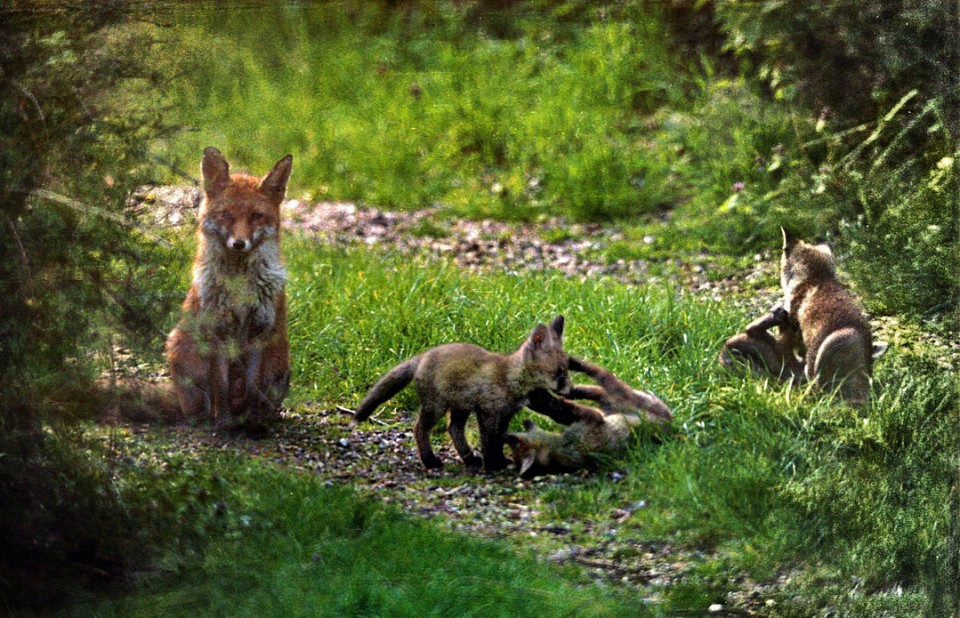
Interestingly, food may also play a role in this promiscuity. A study on Arctic foxes (Vulpes lagopus) by Cassandra Cameron and colleagues at the Université du Québec à Rimouski in Canada, published in Behavioural Ecology during 2011, reports that extra-pair matings were more common where food is abundant, with foxes being more prone to monogamy in areas where food is scarce. A similar observation was made by Cynthia Zabel and Spencer Taggart among the Red foxes of Round Island, Alaska during the early 1980s.
In a paper to Animal Behaviour during 1989, Zabel and Taggart report that polygyny occurred among the foxes, correlated with abundant food (i.e., dogs would mate with more than one vixen when there was lots of food) but, when there was a widespread nesting failure of seabirds on the island as a result of the 1982 El Niño in the Bering Sea, the groups became monogamous (only one vixen bred in each group). The suggestion is that when resources are abundant the females have little to lose by sharing a male, but when times are tough it pays to have someone to help with securing limited resources and putting food on the table. In addition, when food is plentiful more vixens are likely to ovulate so males presumably have a greater choice of potential mates than when food is scarce.
The advantage of polygyny for the dog fox is that he spreads his genes around. Considering that many (especially subordinate) males will only live long enough to breed once or twice, spreading the cubs around helps to ensure that at least some of them survive to pass on their genes. For instance, if the dominant vixen was to die before giving birth, a monogamous dog fox would have to wait a year before he could mate again.
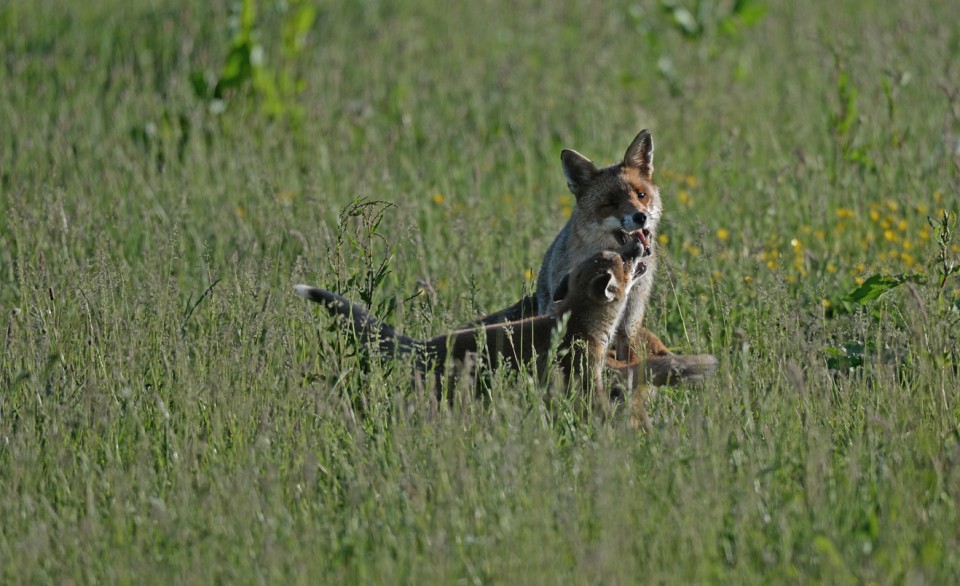
For the female, polyandry helps ensure that her litter has the best possible selection of genes to help them survive whatever life throws at them. At the same time, it seems that a dog fox can be "duped" into helping raise the litter even though only some of the cubs may be his. Indeed, the Bristol team observed that dominant males continued to provide food for the dominant vixen and her cubs, despite some of the cubs being the progeny of a rival male. This suggests that male foxes are unable to discriminate between the cubs that are theirs and those which aren't.
The culmination of this observed polyandry seems to be linked to the patrimony of fox territory. It is not uncommon for successive generations to inherit the territories on which they were born, so the observed promiscuity is probably a strategy to counteract the problems that would arise from inbreeding (i.e., mating within the family group).
Taking sides? The urban-rural divide
Finally, it has often been assumed that urban and rural foxes are distinct entities, with the suggestion that they should be considered different subspecies tabled periodically. The picture here is complicated and seems to vary from city to city.
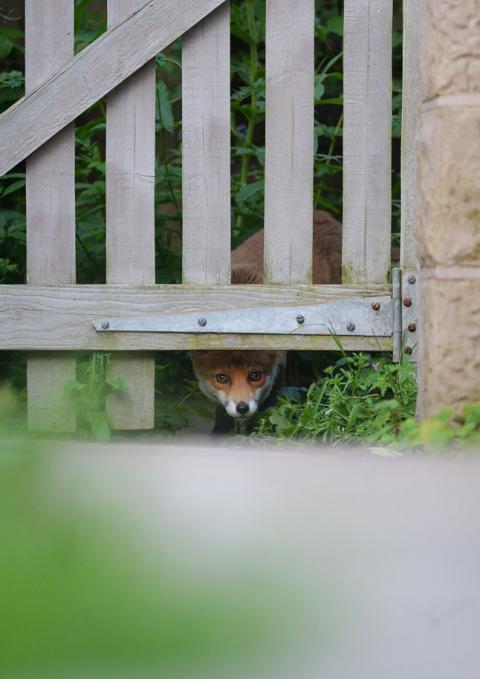
During the early 2000s, Peter Wandeler and his colleagues found that the foxes living in the Swiss city of Zurich interbred freely with those living in peripheral rural areas. The researchers did find a small tendency for urban foxes to breed preferentially with other urban animals and rural animals with other rural animals, but this was probably as much out of convenience as preference. Overall, however, the urban and rural populations were genetically only about 4% different from one another.
In the UK, a study by a team led by Graham Smith at the Food and Environment Research Agency (FERA) in York found the national fox population to be genetically well-mixed. In a 2015 paper, the scientists presented data showing an urban-rural difference of only around 5%. There was some clustering, foxes from East Anglia (Norfolk, Suffolk and Essex) were more similar to each other than those from elsewhere, as were those from southern Scotland and northern England, but overall the differentiation was low.
More recently, work on foxes living in Germany's largest city identified distinct clustering between the two demes. The research, carried out in Berlin by Sophia Kimmig at the Leibniz Institute for Zoo and Wildlife Research and colleagues, found that the administrative city border was a significant barrier to fox dispersal, creating an "urban island" of foxes that was genetically distinct from populations in surrounding countryside. The data do suggest a relatively weak framework at the present time, indicating some dispersal back and forth between urban and rural areas, but the exchange was sufficiently reduced to maintain a clear genetic structure. If the dispersal rate reduces over time, it is conceivable that the Berlin foxes could become isolated from their rural counterparts.